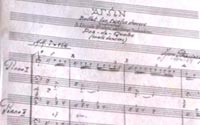A Ballet for Balanchine

Igor Stravinsky (1882-1971)
Agon
Composer's autograph reduction
for two pianos, 1957
Music Division
![[Igor Stravinsky] published in Vanity Fair](images/at0168.2s-th.jpg)
Miguel Covarrubias (1904-1957)
[Igor Stravinsky] published in Vanity
Fair,
October 1925
Prints & Photographs
Division (168.2)
LC-USZ62-86026
|
Igor Stravinsky's ballet Agon (meaning "contest") was first danced
on December 1, 1957, by the New York City Ballet, with choreography
by another Russian emigre artist, George Balanchine (1904-1983).
The music had received its premiere in Los Angeles in a concert
held the previous June, with Robert Craft conducting. As seen here
on the title page of the holograph score, the composer dedicated
the ballet to Balanchine and Lincoln Kirstein, cofounders of the
New York City Ballet.
Agon is the third of three ballet collaborations between Stravinsky
(1882-1971) and Balanchine, the other two being Apollon Musagete
(1928) and Orpheus (1948).
Unlike those previous works, Agon is plotless, an abstract ballet
for eight female and four male dancers. Some of the dances were
suggested by a description of seventeenth-century French court dances,
to which the titles of movements, such as "Bransle Simple," "Bransle
Gay," and "Bransle de Poitou," bear witness.
Another influence was the music of the Second Vienna School, particularly
Anton Webern. Stravinsky had written works using serial procedures
within a tonal context, notably the Cantata of 1952, before beginning
work on Agon in 1953. By the time he finished the ballet in April
1957, he had completed his Canticum Sacrum, which contains sections
employing strict serial technique. Agon itself progresses from a
basically diatonic, fanfarelike opening through a series of increasingly
chromatic movements to a "Pas de deux" that speaks the language
of the late, serial Stravinsky.
Balanchine rose to the musical language of the "Pas de deux" with
a dance for Diana Adams and Arthur Mitchell that became one of the
defining moments of midcentury ballet. The ballet is the artistic
and spiritual triumph of two artists who fled their homeland following
the turbulence of revolution to seek artistic freedom of expression
and who went on to transplant the musical and dance heritage of
Imperial Russia onto American soil with spectacular results that
forever changed dance.
|

